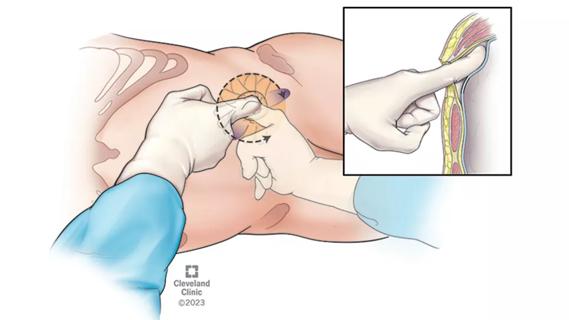Minimally invasive approach is gaining prominence as a fast and safe outpatient procedure
Minimally invasive spine surgery aided by endoscopes can speed patient recovery, reduce postoperative pain and improve outcomes.
Advertisement
Cleveland Clinic is a non-profit academic medical center. Advertising on our site helps support our mission. We do not endorse non-Cleveland Clinic products or services. Policy
“For the right pathologies, endoscopic surgery can really minimize trauma to muscles,” says Michael Steinmetz, MD, Chair of Cleveland Clinic’s Department of Neurosurgery and Director of its Center for Spine Health. “You can sometimes do it without removing any bone and sometimes with almost no blood loss. It’s all done through the very small endoscope, which may have an outer diameter of eight or nine millimeters.”
In the latest episode of Cleveland Clinic’s Neuro Pathways podcast, Dr. Steinmetz shares insight on the evolving field of endoscopic spine surgery. He discusses:
Click the podcast player above to listen to the 26-minute episode now, or read on for a short edited excerpt. Check out more Neuro Pathways episodes at clevelandclinic.org/neuropodcast or wherever you get your podcasts.
This activity has been approved for AMA PRA Category 1 Credit™ and ANCC contact hours. After listening to the podcast, you can claim your credit here.
Podcast host Glen Stevens, DO, PhD: Let’s say I trained at a program that didn’t offer this, but I’m out in practice and I want to work this technology into my capabilities. How do I go about doing the training?
Advertisement
Dr. Steinmetz: This is what’s happening as surgeons who have been in practice for a few years begin to want to apply this technology. The pathway I would suggest involves taking advantage of courses that are now being taught at our national meetings and courses being taught by industry itself — companies that make endoscopes — including both didactic and cadaver-based courses.
I would advise someone who’s never done this but wants to try it to first go to a few of these courses. Maybe two or three of them where they’re cadaver-based and didactic, where you’re learning the technology, you’re learning how to target the spine with the endoscope to get into the spine safely.You’re understanding the anatomy, how the scope works, and you’re doing it on a cadaver or even a simulator so that you get comfortable with it.
Even at that point, before applying it to your clinical practice, I would recommend going to observe a program — coming to Cleveland Clinic or another dedicated endoscopic spine program — to watch those surgeons and the pathologies they treat so you can see what they’re doing. You can watch it all on a TV screen, which is beautiful for an observer. It’s not direct observation. The endoscopist is actually looking at a TV screen, which is what you would be looking at, so you can see the anatomy and the pathology, see what it looks like when there’s still compression, see what it looks like after it’s decompressed, and you can understand that fully.
I’d recommend only moving into clinical practice when you’ve got enough technical skills on a cadaver or a simulator — probably more than once, maybe more than twice — and you’ve observed it in real practice. Then perhaps you can try it in a very easy, straightforward procedure like a transforaminal discectomy. I would strongly recommend that type of pathway before taking this on in clinical practice.
Advertisement
Advertisement

Success for these complex operations requires judicious patient selection and presurgical patient optimization

Meta-analyses signal an opportunity to reshape risk stratification and surgical protocols for these comorbidities

A preview of Cleveland Clinic’s emerging AI platform for spine care decision-making

Least-invasive open-heart AVR option to date yielded rapid recovery in all cases

First single-port renal vein transposition reduces recovery time and improves outcomes

Rare pregnancy complication can lead to fetal demise

Approach offers a ‘middle ground’ between radical prostatectomy and active surveillance

The low anterior access approach using the single-port robot is gaining attention within the field